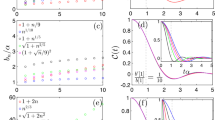Abstract
This paper is the first of a series where we study quantum channels from the random matrix point of view. We develop a graphical tool that allows us to compute the expected moments of the output of a random quantum channel.
As an application, we study variations of random matrix models introduced by Hayden [7], and show that their eigenvalues converge almost surely.
In particular we obtain, for some models, sharp improvements on the value of the largest eigenvalue, and this is shown in further work to have new applications to minimal output entropy inequalities.
Similar content being viewed by others
References
Coecke, B.: Kindergarten quantum mechanics—lecture notes. In: Quantum Theory: Reconsideration of Foundations—3, AIP Conf. Proc. 810, Melville, NY: Amer. Inst. Phys., 2006, pp. 81–98
Collins B.: Moments and Cumulants of Polynomial random variables on unitary groups, the Itzykson-Zuber integral and free probability. Int. Math. Res. Not. 17, 953–982 (2003)
Collins, B., Nechita, I.: Random quantum channels II: Entanglement of random subspaces, Renyi entropy estimates and additivity problems. http://arxiv.org/abs/0906.1877v2[math.PR], 2009
Collins, B., Nechita, I.: Gaussianization and eigenvalue statistics for Random quantum channels (III) http://arxiv.org/abs/0910.1768v2[quant-ph], 2009
Collins B., Śniady P.: Integration with respect to the Haar measure on unitary, orthogonal and symplectic group. Commun. Math. Phys. 264(3), 773–795 (2006)
Hastings M.B.: Superadditivity of communication capacity using entangled inputs. Nature Physics 5, 255–257 (2009)
Hayden, P.: The maximal p-norm multiplicativity conjecture is false. http://arxiv.org/abs/0707.3291v1[quant-ph], 2007
Hayden P., Leung D., Winter A.: Aspects of generic entanglement. Commun. Math. Phys. 265, 95–117 (2006)
Hayden P., Winter A.: Counterexamples to the maximal p-norm multiplicativity conjecture for all p > 1. Commun. Math. Phys. 284(1), 263–280 (2008)
Jones, V.F.R.: Planar Algebras. http://arxiv.org/abs/math/9909027v1[math.QA], 1999
Joyal A., Street R., Verity D.: Traced monoidal categories. Math. Proc. Cambridge Philos. Soc. 119(3), 447–468 (1996)
Nechita I.: Asymptotics of random density matrices. Ann. Henri Poincaré 8(8), 1521–1538 (2007)
Nica, A., Speicher, R.: Lectures on the Combinatorics of Free Probability. Volume 335 of London Mathematical Society Lecture Note Series. Cambridge: Cambridge University Press, 2006
Author information
Authors and Affiliations
Corresponding author
Additional information
Communicated by M.B. Ruskai
Rights and permissions
About this article
Cite this article
Collins, B., Nechita, I. Random Quantum Channels I: Graphical Calculus and the Bell State Phenomenon. Commun. Math. Phys. 297, 345–370 (2010). https://doi.org/10.1007/s00220-010-1012-0
Received:
Accepted:
Published:
Issue Date:
DOI: https://doi.org/10.1007/s00220-010-1012-0




